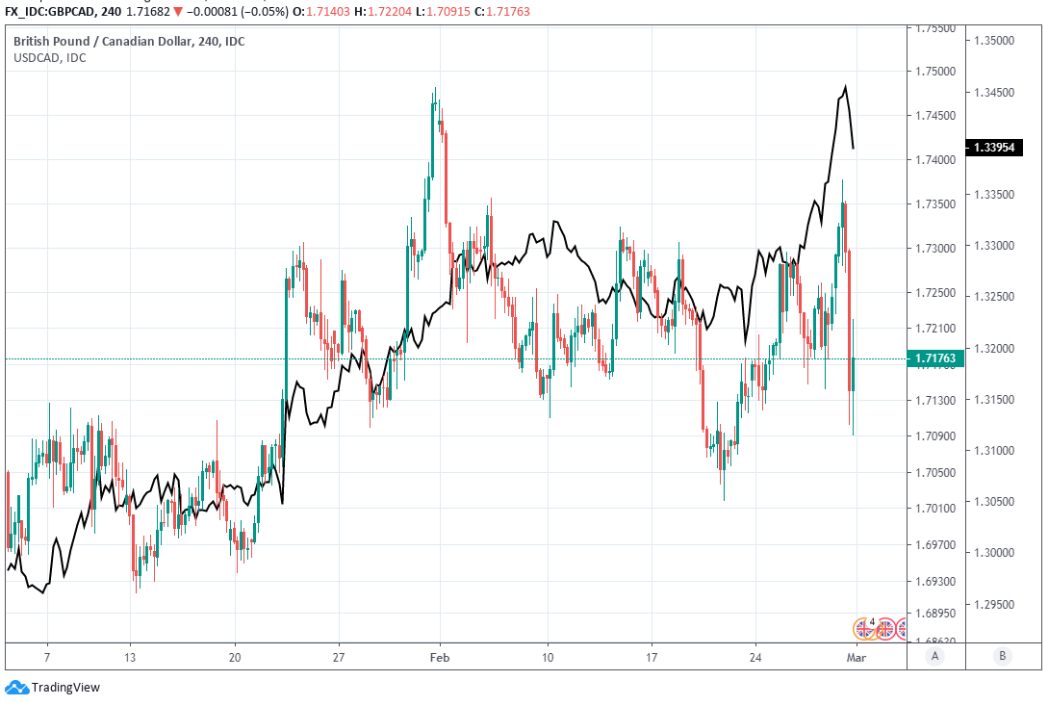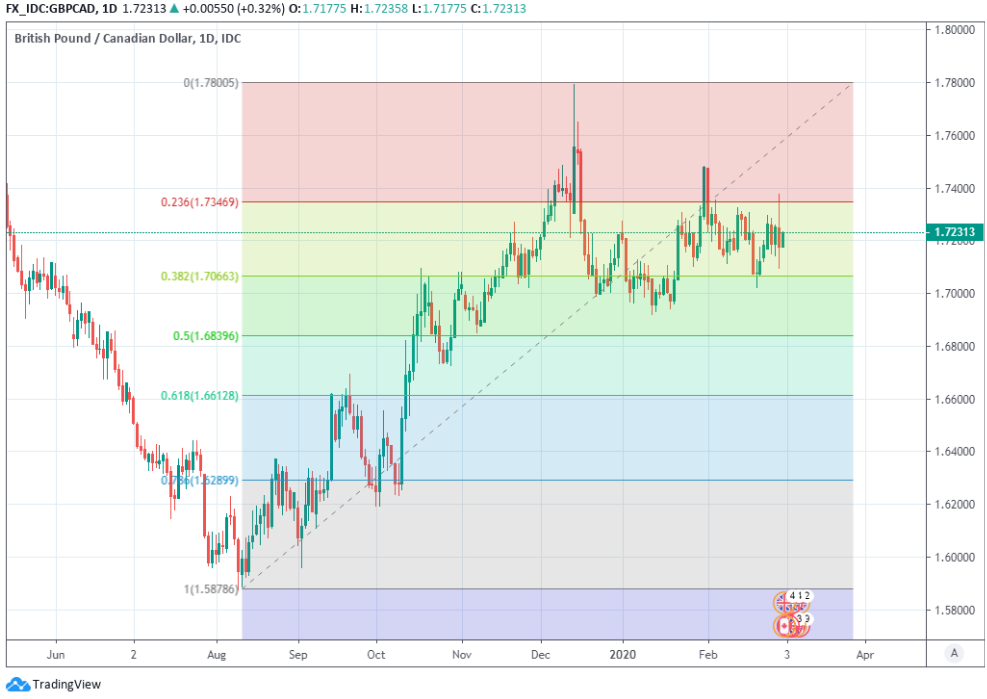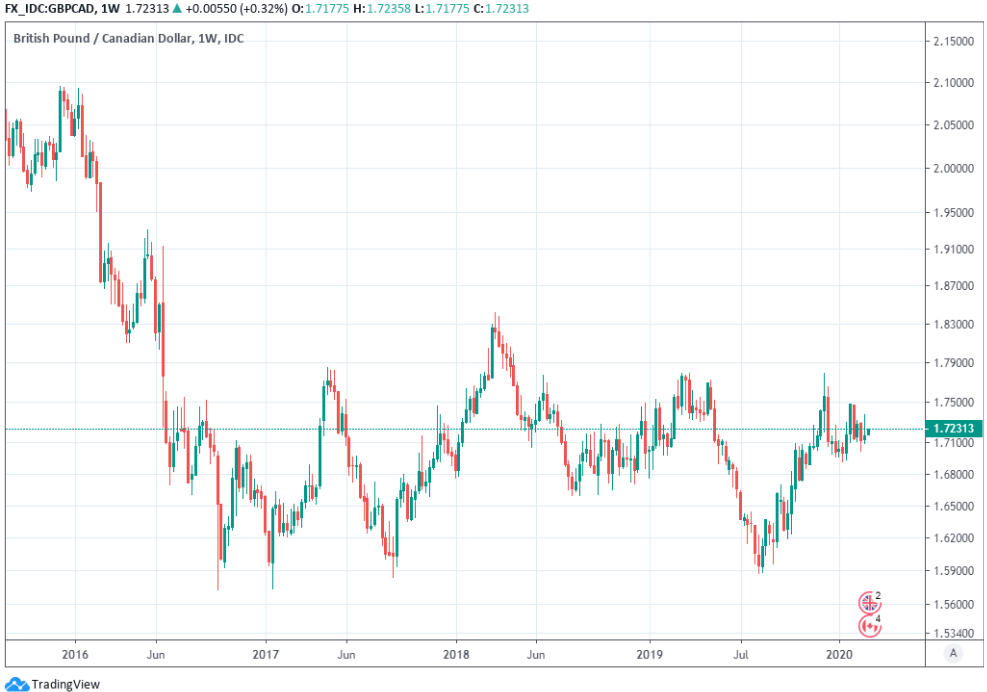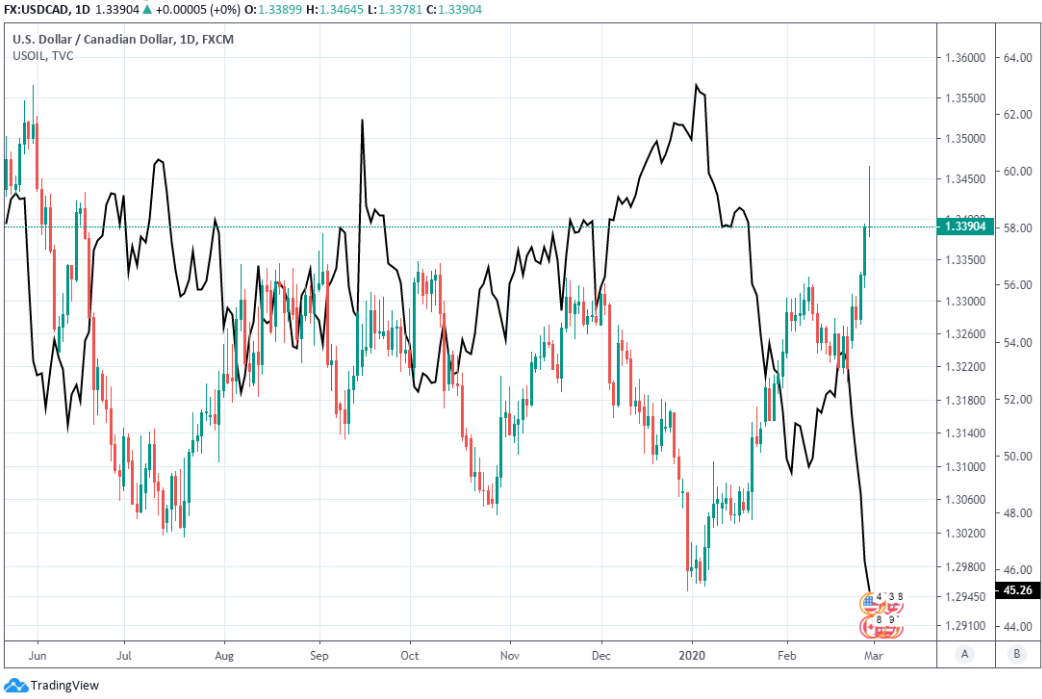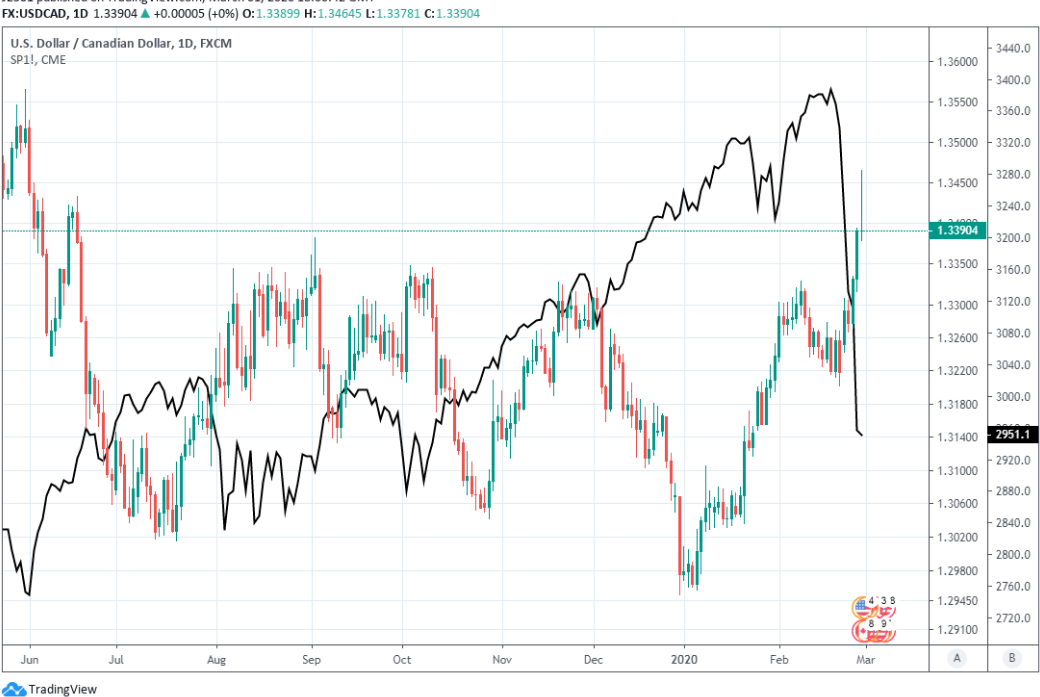The Pound-to-Canadian Dollar Week Ahead; Sterling in Ailing Health
- Written by: James Skinner
-
- GBP/CAD gains just 0.14% last week amid risk sell-off.
- Uptrend intact on the charts but risk abounds this week.
- CAD more vulnerable to bad sentiment but GBP is sickly.
- Amid signs of coronavirus outbreak on borders of London.
- GBP vulnerable to outflows, risk of containment measures.
- As CAD set to suffer from oil losses and a BoC rate cut.
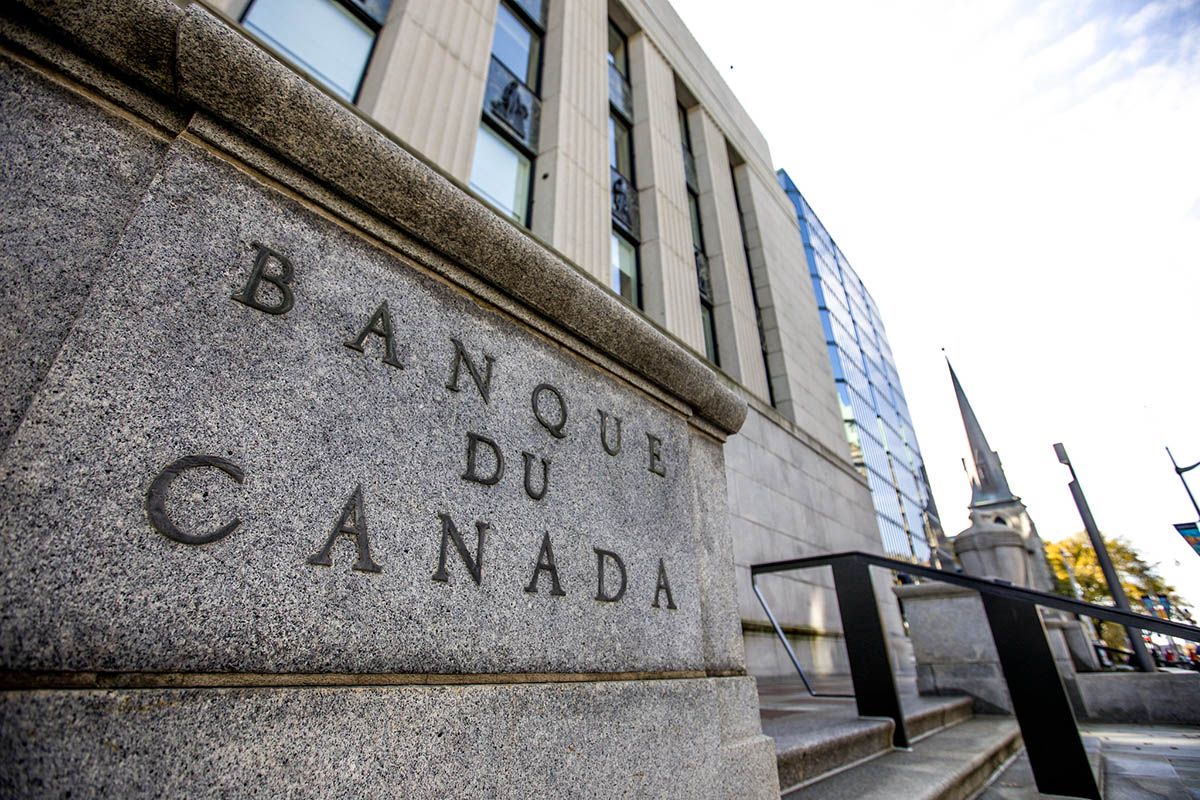
Image © Bank of Canada, Reproduced Under CC Licensing
- GBP/CAD Spot rate: 1.7176, up +0.14% last week
- Indicative bank rates for transfers: 1.6557-1.6697
- Transfer specialist indicative rates: 1.6920-1.7023 >> Get your quote now
The Pound-to-Canadian Dollar rate rose last week as the oil prices slumped amid a global risk sell-off, helping to keep the technical uptrend alive on the charts although the first signs of a coronavirus outbreak in the UK could mean support for the British currency is tested over the coming days.
Pound Sterling suffered a punishing sell-off against larger rivals heading into the weekend although larger losses for Canadian Dollar, relative to the greenback, helped the Pound-to-Canadian Dollar rate to retain an upward slant.
The Loonie was left reeling with oil prices entering bear market territory while global stock markets snapped at their heels, although stocks are not yet across the -20% threshold required.
“The CAD has been under more intense selling pressure over the past week,” says Lee Hardman, a currency analyst at MUFG. "It has resulted in USD/CAD rising to its highest level since the middle of 2019. After breaking to upside out of the range between 1.3000 and 1.3350 which had held for almost nine months, the next key resistance level for USD/CAD is provided by the May 2019 high at 1.3565, and then beyond by the December 2018 high at 1.3665."
The Canadian Dollar might have an easier time overcoming Sterling this week after Saturday brought the first recorded instance of somebody having caught the coronavirus inside the UK, which could weigh on the Pound even if the technical picture remains supportive. But the Loonie will also be at risk if turmoil continues and the Bank of Canada (BoC) does as some influential economists say it will now do and cuts the cash rate on Wednesday.
Above: Pound-to-Canadian Dollar rate shown at 4-hour intervals alongside USD/CAD rate (black line).
“The GBP needs to hold support around the 1.70 line in order to keep the extension higher in play,” says Juan Manuel Herrera, a strategist at Scotiabank in a research note early last week. “Longer run trend strength signals suggest the GBP retains a lot of upside momentum, even if shorter term signals are flat and favour more range trading for now. GBP gains through 1.7150 (40-day MA) are mildly constructive. Bullish above 1.7335/40.”
A first case of coronavirus was identified in England on Saturday in which the disease was thought to have been “passed on in the UK,” Chief Medical Officer Chris Whitty said. Possibly the first sign of a 'community outbreak.’
A man and subsequently others were found with the viral pneumonia in an undisclosed part of the county of Surrey, which sits on the border of London. A primary school teacher in Reading, Berkeshire - another county bordering London - was confirmed to be suffering from virus. And there has since been an incidence of possible ‘community infection’ in Essex, another county bordering the capital London. The UK had 35 confirmed cases as of Sunday afternoon.
“The clear and obvious risk, which the financial markets are already contemplating, is that things get worse before they get better. That could include a further weakening in the global economy as the number of cases of coronavirus in Europe and the US rise and/or their governments shut down parts of their economies to control the spread of the virus,” says Paul Dales, chief UK economist at Capital Economics in a note to clients Friday.
Above: Pound-to-Canadian Dollar rate shown at daily intervals with Fibonacci retracements of 2019 uptrend marked out.
The British government is expected to encourage companies to allow more staff to work from home in its updated action plan this week. It's also likely to discourage unnecessary travel as part of a ‘social distancing’ strategy that would delay the peak of the outbreak until later in the year.
The U.S. government also confirmed its first death case at the weekend and the White House has told Americans to expect more over the coming weeks. The Italian government had declared 1128 cases of coronavirus as of Saturday, with close to a thousand in the Lombardy, Veneto and Emilia-Romagna regions.
Eleven Italian towns are under “lockdown” with nobody able to enter or leave affected areas and that government has now legislated to suspend payment deadlines for all debts to local authorities in the affected areas and provided for a EUR500 stipend to workers in those areas for at least the next three months.
And following the weekend’s events the idea that such disruptive restrictions may soon be seen in the world’s most developed economies, and hubs of global finance, can no longer be deemed far-fetched.
“Coronavirus may very well be a challenge in the weeks and months ahead. But I have no doubt that with the help of the NHS and its incomparable staff this country will get through it – and beat it," says Prime Minister Boris Johnson, will chair a meeting of COBRA on Monday as the government prepares to publish an updated action plan on the response expected of the health care system and the public to COVID-19. Further details are below.
Above: Pound-to-Canadian Dollar rate shown at weekly intervals.
AA
The Canadian Dollar: What to Watch
The Canadian Dollar was left reeling last week after oil prices fell by their largest amount since November 2018 and stock markets had their worst week since the financial crisis, although the going could get tougher still in the days ahead if some influential economists are with their revised projections that the Bank of Canada will cut the cash rate this Wednesday to minimise the hit to confidence stemming from the evolving coronavirus crisis.
Oil prices entered bear market territory after falling more than 13% last week in the bloodiest period since the height of the U.S.-China trade war, taking the 2020 loss to 24.1% for Brent crude and well past the 20% decline required to signal a bear market. This has hit the oil-sensitive Loonie at the same time as stock markets rolled over into ‘correction territory’ with their worst losses since October 2008, and the Loonie is positively correlated with those ‘risk markets.’
“Fears over COVID-19 disruption should continue to favour CAD underperformance. The unwinding of carry positions and narrowing of yield spreads between Canada with the rest of the world are undermining the CAD. The lower price of oil if sustained also justifies a shift to a lower equilibrium value for CAD. A move back towards the December 2018 high at 1.3665 appears to be on the cards,” says MUFG’s Hardman.
Above: USD/CAD rate shown at daily intervals, alongside WTI crude oil futures price.
Financial markets have gone into freefall and bond yields have seen new all-time lows as investors increasingly contemplate the downside of a global coronavirus not-pandemic for economies that were already slowing a long time before the viral pneumonia established itself in China, but which will face potentially momentous disruption in the event that enforced quarantine measures are rolled out in order to contain the spread of the disease.
The coronavirus-induced sell-off has been so severe that economists and analysts are increasingly looking toward central banks for more than just words, and the BoC will have an opportunity to indulge them this week. Consensus still favours an unchanged cash rate from Wednesday’s 15:00 decision although local firms are increasingly suggesting the bank could cut the cash rate to 1.50% to provide reassurance to households and companies.
“We are revising our call for next week’s Bank of Canada meeting and now look for policymakers to announce a 25 bps cut to the policy rate. The plunge in global equity markets and sharp drop in commodity prices, in particular oil, are bumping up the risks that the confidence hit in financial markets will be mirrored in household and business sentiment. The data doesn’t show this yet but with markets extrapolating what looked like a modest hit to global growth from the coronavirus into a full-fledged economic downturn, the bank is likely to want to lean against any deterioration in confidence. There is even the possibility of a coordinated central bank easing in the days ahead,” says Dawn Desjardins, group deputy chief economist at Royal Bank of Canada.
Above: USD/CAD rate shown at daily intervals, alongside CME S&P 500 futures.
AA
Pound Sterling: What to Watch
Pound Sterling received a drubbing heading into the weekend after the government put the idea of an ‘Australia deal’ Brexit on the table ahead of trade talks with the EU this week and as stock markets crumbled across the globe in response to the increasingly rapid spread of coronavirus outside of China, both being things that may continue to pressure the Pound in the week ahead.
The British government is expected to encourage companies to allow more staff to work from home in its updated action plan this week. It's also likely to discourage unnecessary travel as part of a ‘social distancing’ strategy that would delay the peak of the outbreak until later in the year.
It's also expected to allow the "emergency registration" of staff who've left the health service to combat staff shortages in the event of a large outbreak. The document will be published this week and will also outline steps the government will take to manage COVID-19 if there is a sustained UK epidemic.
This and the weekend’s events mean households, companies and investors could now potentially be facing a momentous disruption to the ordinary course of business and it's not possible for anybody to reliably say how long such disruption might last for or what other effects it could have. For Pound Sterling, which underwrites a financial sector where assets under management are more than three times the UK’s annual GDP, this could be very bad news.
"The pound is a structurally weak currency and it remains sensitive to global investors' appetite for risk. Large capital inflows are required to keep sterling stable, given that the U.K. runs a persistent current account deficit, equal to nearly 4% of GDP. Sterling depreciated by 25% during the 2007/08 crisis primarily due to a global pullback in cross-border finance, not a material shift in interest rate differentials," says Samuel Tombs, chief UK economist at Pantheon Macroeconomics. "If virus-related anxiety causes investors globally to pause on all risky acquisitions, or, in the worst case, de-risk their existing portfolios, sterling likely will struggle again."
Sterling is underpinned by continuous flows of external finance into and out of both the exchequer as well as City of London, although if a coronavirus outbreak were to be found on the borders of the capital then the City’s ability to continue functioning may be questioned. There are many different scenarios in which those financial inflows might dry up or be dwarfed by outflows from capital, and all of those scenarios would be bad news for the Pound.
Already the turmoil in financial markets was significant enough to have prompted some economists to contemplate the prospects of the Bank of England (BoE) feeling compelled to issue a statement over the coming days, and to potentially even cut interest rates in the weeks ahead. Pound Sterling is not prepared for an interest rate cut because on Friday the overnight-index-swap implied Bank Rate for March 26 was just 0.61%, above the 0.50% that would prevail following an actual cut.
Federal Reserve Chairman Jerome Powell issued a statement Friday.
“Even if the financial markets just continue to fear such developments and equity prices continue to fall by 3% a day, then the MPC may act. If so, then its next scheduled meeting on 26th March feels a long way away. It could release a statement before then, perhaps coordinated with other central banks, saying it is ready to provide support and liquidity if needed. And if that doesn’t do the job, we wouldn’t rule out the MPC cutting rates at an emergency meeting,” says Capital Economics’ Dales.
There are no major economic figures expected from the UK in the week ahead although the Brexit negotiations will begin in the shadow of the coronavirus story and with each side having conflicting demands and a confrontational stance.
This matters more for the Pound in the medium-term after the government said last week the UK could walk away from the trade talks with the EU if the broad outline of a deal has not been reached before June.
“The UK and the EU will sit at the negotiating table on Monday and we suspect the highly confrontational tone after the recent remarks by UK officials will keep prevailing in the headlines. This should translate into additional uncertainty regarding the future of UK trade relationships with the bloc and selling pressure on sterling should remain sustained,” says Chris Turner, head of FX strategy at ING. “In light of this we may see EUR/GBP consolidate above 0.85 and GBP/USD edging below 1.28 next week.”





